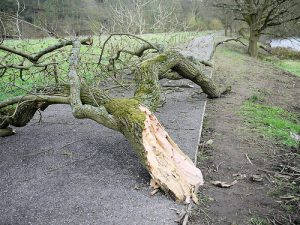Seemingly large healthy branches can occasionally and suddenly drop off mature trees during calm summer weather. The unexpected fall of a large limb is unnerving and can make us start to feel uneasy about the tree. After all, the once venerable old tree now appears to pose a risk to people and property.
The questions that arise are: Will other limbs begin to fall without warning? Is the tree collapsing? Will it fall down during the next storm?
What we know
Not much is known about this condition or ‘syndrome’. Here is what we do know.
- ‘Summer branch drop’ has been reported occurring on native and ornamental planted trees, including irrigated and unirrigated landscapes. Reports have come in from Europe, Australia, Africa and the United States.
- Branches that drop are frequently long and drawn out, at least 4 inches in diameter, and usually extend to or beyond the edge of the tree’s canopy. Frequently, but not always, the break occurs 3 to 12 feet distance from a fork.
- As ‘Summer branch drop’ is believed to be associated with calm weather conditions following a heavy rain shower which terminates a period of increasing soil dryness. The trigger may be water stress.
- The branch drop often occurs with a loud explosion. When inspected, the tree that has withstood centuries of storms, shows no sign of weakness at the point of breakage.
- Trees associated with ‘summer branch drop’ have been known to drop more limbs.
What can we do
- Following the first large branch dropping immediately have your tree inspected by an International Society of Arboriculture – Certified Arborist.
- The ISA Certified Arborist will recommend removal of unsafe branches and can identify branches that are at risk due to their weight or decay. You should request a written report and expect some recommended pruning to reduce large limb length and thinning of the canopy.
These two steps should be standard practices for all property owners with large trees. These practices will also help reduce the chance of tree failure during high wind storms.
How to Hire an ISA Certified Arborist
 0
0

